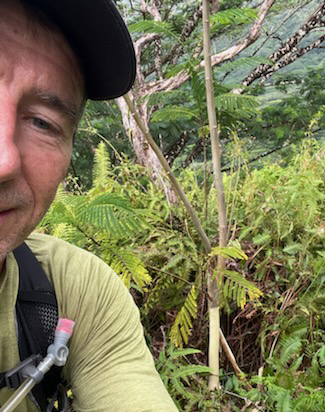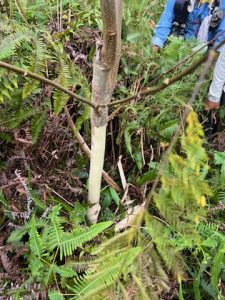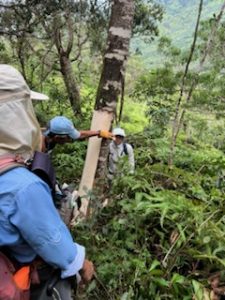Albizia Tree Experience

Invasive to Hawaii the Albizia tree maybe the fastest growing tree in the world.
On Sunday November 19, 2023, the HTMC trail clearers were in Kahana Valley clearing and Ring-Barked nine Albizia trees. Ring-Barking is a way of killing Albizia trees by removing the bark at the trunk of the tree. The 9 trees were on or next to the trail. Our own Larry Lee, became concerned that when the big trees fall, sometime in the future, it will destroy the trail. Part or most of the root system is probably under the trail and when the trees fall, it may uproot the narrow ridge trail. We often see uprooted trees with their huge root-balls above ground, creating large holes in the ground where the roots uprooted.
Melani from the Ko’olau Mountains Watershed Partnership, who runs the Outreach program, told us that ring-barking the trees like we did causes them to stop growing and slowly die then fall apart in place over a number of months or even years. The bark layer that was cleared is where the trees would transport water from the roots to the crown of the tree. With that base section clear, there is no way for the tree to move the water, so the top will slowly dehydrate, lose all of its leaves, seeds and die. As it loses the water stored in the tree, it will end up lighter at the top because the water won’t reach there anymore and that reduces the likelihood that it will fall over and rip out mounds of dirt. It is never a 0% chance, but it is much less likely to happen with this treatment. I have not personally seen any large Albizia uproot themselves after ring-barking like this, but what I have seen is the dead trees snapping at the top cut line for stripping the bark. So please be sure to carefully assess the trees and look at what is near the tree if it were to break and fall.
Always avoid treating Albizia trees that are potential fall hazards for homes, businesses, infrastructure and hikers if they were to snap near the bottom.
As for cutting into the trees either partially or completely in the ring-barking area, she would not recommend it because of how they are likely to respond to that. Typically, when Albizia trees are cut, they either coppice or send up suckers because the damage is significant enough to elicit a sort of last ditch effort to save itself. If you cut down an Albizia and you have not ring-barked it, you will almost certainly get some coppicing which is where the tree sends up a bunch of new sprouts from the top and sides of the stump. These new branches tend to be weaker and shear off easier making them more hazardous if the tree grows tall.
Albizia trees that are cut whether they are ring-barked or not, tend to react to that damage by sending their energy stores down to the roots and if they have enough sugar there is a signal for the roots to send up new shoots called suckers from the root systems in an attempt to get more sunlight and sugars to survive. If they succeed at growing like this, then they will be harder to remove next time because you need to ring bark each of those suckers to fully remove the tree. They will also be more likely to uproot in the future because the roots that supported a single tree will now be supporting several trunks instead of just one.
The best course of action is to ring bark the Albizia tree and leave the tree to break down slowly. The top will dehydrate first, and it will drop the leaves, stop making seeds, this lightens the weight of the tree top and makes it less likely to blow over in a storm. Then the tree will slowly use up all of the sugar in the roots because it is not able to photosynthesize with the dried-up dead leaves and because cutting the bark also cuts most of the tubes that the plant uses to transport sugar from the leaves to the roots. The reason this ring-bark method does not kill the tree very quickly is that these sugar stores can last a long time.
You don’t want to get impatient and cut the tree before the sugar is fully depleted or it will respond to that damage by using the remaining sugar to grow new shoots. Luckily, using the ring bark method kind of tricks the plant into not noticing that it has been damaged and it slowly dies, kind of like that old apologue about the frog that jumps out when you toss it in boiling water, but when you start in warm water that slowly gets hotter and hotter, it doesn’t realize it is being cooked and never jumps out. When the tree has dehydrated and used up the sugar stores, it is dead and will start to break down on its own.
https://koolauwatershed.org/albizia/
Keep your eye out for an Albizia Event at the clubhouse in 2024!




